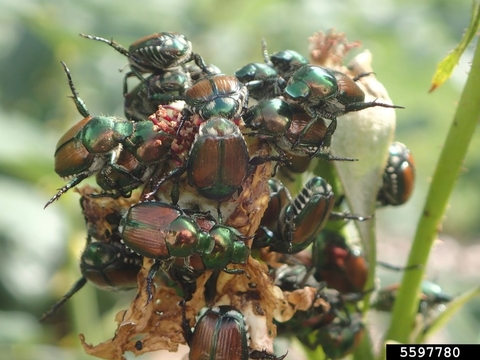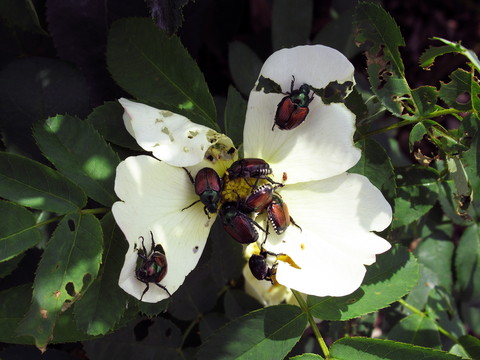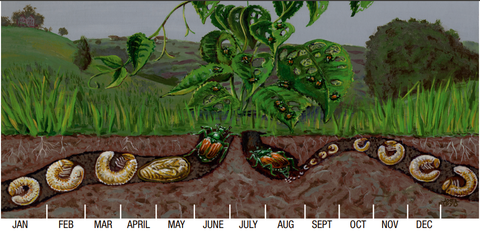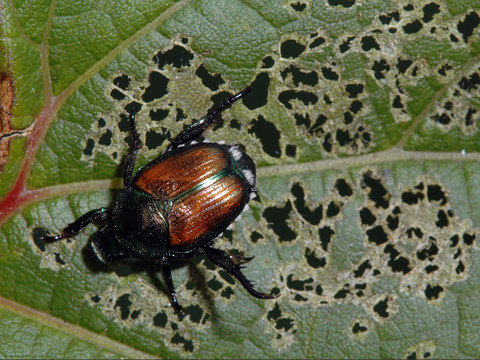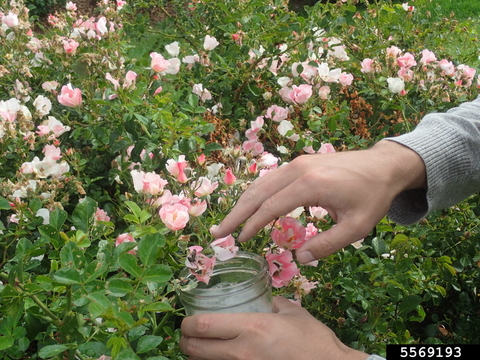Over the last few weeks, Japanese beetles have made an unwelcome return to Minnesota gardens. These gleaming copper and green beetles have been in Minnesota for decades but became a more prominent pest in the last decade. This year’s batch of adult beetles started to show up recently, and models indicate that we have only seen a small percentage of the total number of beetles we will be dealing with this season. Expect to keep seeing beetles through mid-August.
What’s a gardener to do? Take a deep breath and read on.
Feeding is a nuisance but not often deadly
A key thing to remember about adult Japanese beetles is that while feeding is an eyesore, it typically does not cause long-term damage to otherwise healthy plants.
Mature shrubs and trees, if healthy, can tolerate a lot of damage without long-term consequences. While beetles may feed on rose flowers, if the plant is healthy, it will make it through the feeding.
Note that this is true for healthy plants. Drought-stressed, young or sick plants in your yard and garden may require more Japanese beetle control efforts than in the past. Much of Minnesota is in its third consecutive year of drought. If you are seeing Japanese beetles in your trees, make sure trees are getting an inch of water a week to reduce the stressors on your trees.
If the beetles are feeding on plants you prune in mid- to late-summer, think of the beetles as doing the pruning for you.
What can I do about Japanese beetles?
The lowest-input method? Learn to live with them.
Want an all-natural, hands-off, pesticide-free way to manage Japanese beetles? Manage your own expectations and learn to live with them.
The plants in our garden are part of the natural world, and as such, are going to be fed on. While the Japanese beetle isn’t a native insect, it is in Minnesota and here to stay.
Japanese beetles have been established in other parts of the Great Lakes region for decades, and people still have green lawns, productive vegetables and beautiful flowers. Beetle populations fluctuate year-to-year, driven by how successful the grubs are at finding turf to feed on, which is harder for them in years when July and August are dry. Does this sound like any lawns you knew last year? The impact of the last two years of drought on Japanese beetles may be revealed in the next few weeks.
There are parasitoid wasps and flies that lay eggs in and on Japanese beetles that have been reported in Minnesota. But studies in other states have shown that the establishment of these beneficial insects is highly variable, so it may be a long time before they make a dent in Minnesota beetle populations.
In most situations, plants can power through the largely cosmetic Japanese beetle feeding. Changing your garden expectations will save you money, sprays and stress.
Want to actively manage them? Start yesterday (though now is also good)!
Peak Japanese beetle population typically occurs in late July. Ideally, start removing adults as soon as they appear. A feeding Japanese beetle puts out smells that attract other Japanese beetles, so a few beetles feeding in an area can quickly become dozens.
The earlier you start working on getting beetle numbers and feeding down, the easier the rest of your summer will be.
Want to manage beetles “organically”? Roll up your sleeves.
Physically removing beetles is highly effective and the most practical option in many gardens. While walking through the garden (especially in the morning or evening), pluck beetles off plants as you see them. A bucket of soapy water can be a good companion on these walks, as beetles can be flicked into them.
Busy? Let the neighborhood kids skip the lemonade stand and pay them a nickel per beetle they pick.
There can be a temptation to try to let a trap do the physical removal for you, but in general, traps tend to do more harm than good. In research studies, traps have been found to actually bring more beetles to an area. While some beetles end up in the trap, many end up outside of it - mating, feeding and laying eggs.
Research traps in Minnesota meant to monitor Japanese beetle populations have caught more than 5,000 beetles a day. If that is how many ended up in the trap, imagine how many of these clumsy beetles ended up nearby.
Thinking about spraying? Think hard before picking up the bottle.
Short on time, long on beetles? There are pesticides that can work, but they need to be used correctly, and correctly means more than turning the nozzle to the “spray” position.
It may seem like the hardest part of picking out a pesticide is asking for opinions on Facebook or selecting something from a wall of products at the hardware store. However, the real challenge in using pesticides is choosing the right product and applying it according to label directions. Make sure the product can be used on Japanese beetle adults and on the plant you want to treat.
With so much hot, dry weather, also check for any information about weather conditions on the label. In hot weather, there is an increased risk of products drifting and damaging plants.
It is annoying to peel open the little booklet affixed to a spray bottle, but it is not optional: it is the law! The label of a pesticide will tell you how to keep yourself, your family and your plants safe while using the product, as well as how to use the product effectively.
While mixing up something from your pantry means there isn’t a label to read, that doesn’t mean what you make will be safe or effective. Homemade remedies may not kill adult beetles and can potentially hurt plants and non-target insects.
For more information on Japanese beetle control, including insecticide options, see Japanese beetles in yards and gardens.
Althoff, Emily R., and Kevin B. Rice. "Japanese beetle (Coleoptera: Scarabaeidae) invasion of North America: History, ecology, and management." Journal of Integrated Pest Management 13.1 (2022): 2.
Cappaert, D. L., & Smitley, D. R. (2002). Parasitoids and pathogens of Japanese beetle (Coleoptera: Scarabaeidae) in southern Michigan. Environmental Entomology, 31(3), 573-580.
Carter Gordon, F., & Potter, D. A. (1985). Efficiency of Japanese beetle (Coleoptera: Scarabaeidae) traps in reducing defoliation of plants in the urban landscape and effect on larval density in turf. Journal of economic entomology, 78(4), 774-778.
Carter F. Gordon, Daniel A. Potter, Japanese Beetle (Coleoptera: Scarabaeidae) Traps: Evaluation of Single and Multiple Arrangements for Reducing Defoliation in Urban Landscape, Journal of Economic Entomology, Volume 79, Issue 5, 1 October 1986, Pages 1381–1384, https://doi.org/10.1093/jee/79.5.1381
McDonald, R., Puttler, B., Klein, M., Oliver, J., Grundler, J., Brown, M. E., ... & Burfitt, C. (2020). Establishment of Tiphia vernalis (Hymenoptera: Tiphiidae), a Naturalized Parasitoid of the Japanese Beetle, Popillia japonica (Coleoptera: Scarabaeidae), in Meramec State Park, Sullivan, Missouri, USA. Journal of Entomological Science, 55(1), 130-136.
Switzer, P. V., Enstrom, P. C., & Schoenick, C. A. (2009). Behavioral explanations underlying the lack of trap effectiveness for small-scale management of Japanese beetles (Coleoptera: Scarabaeidae). Journal of economic entomology, 102(3), 934-940.


